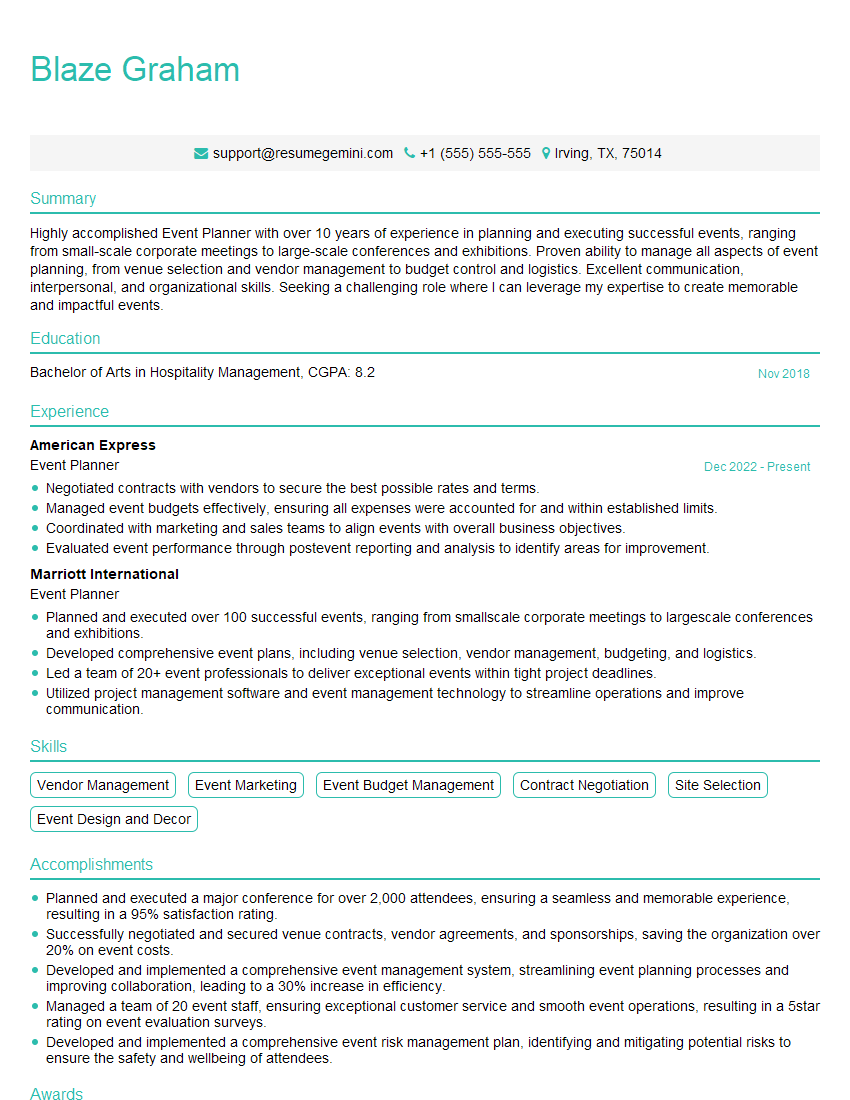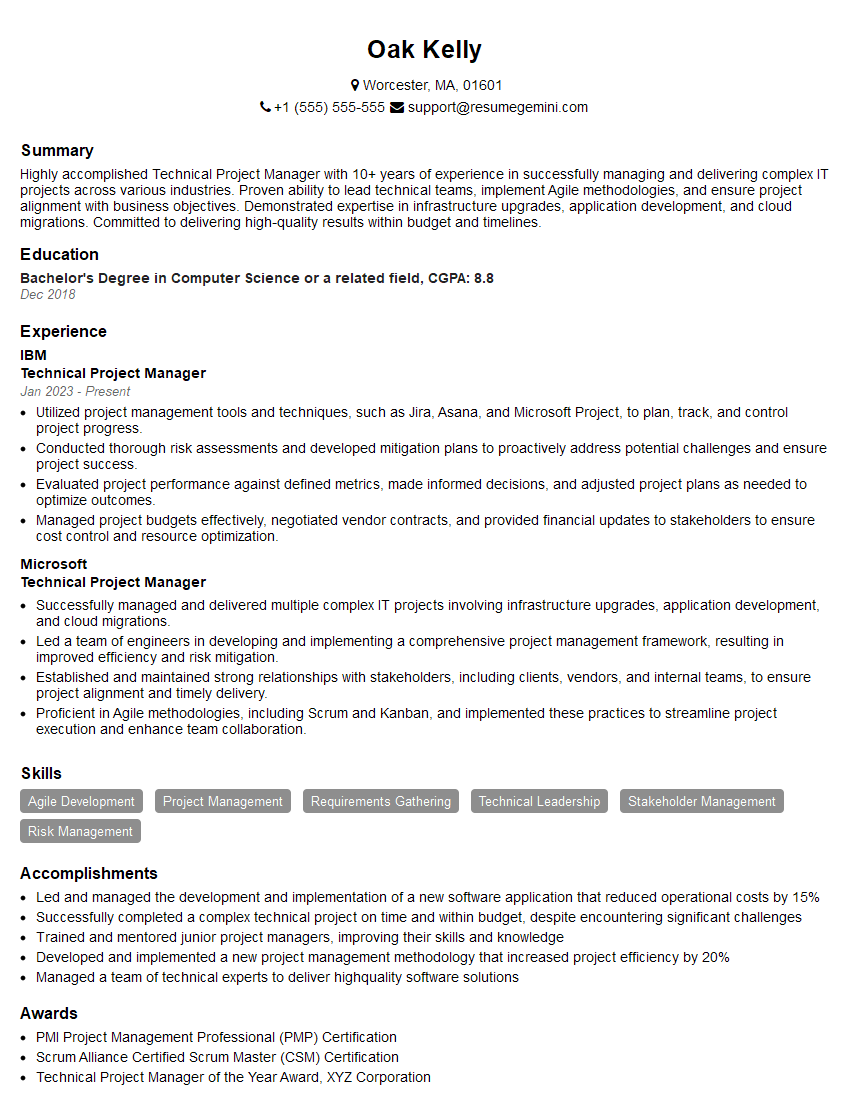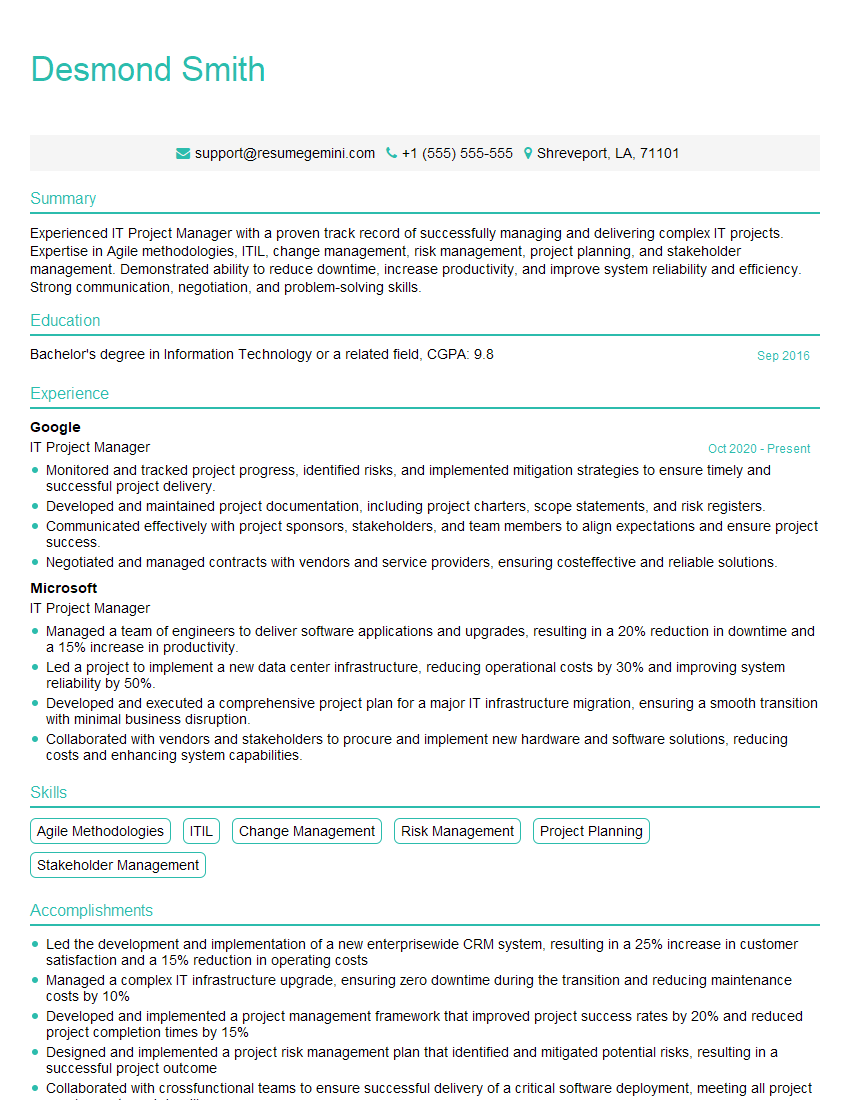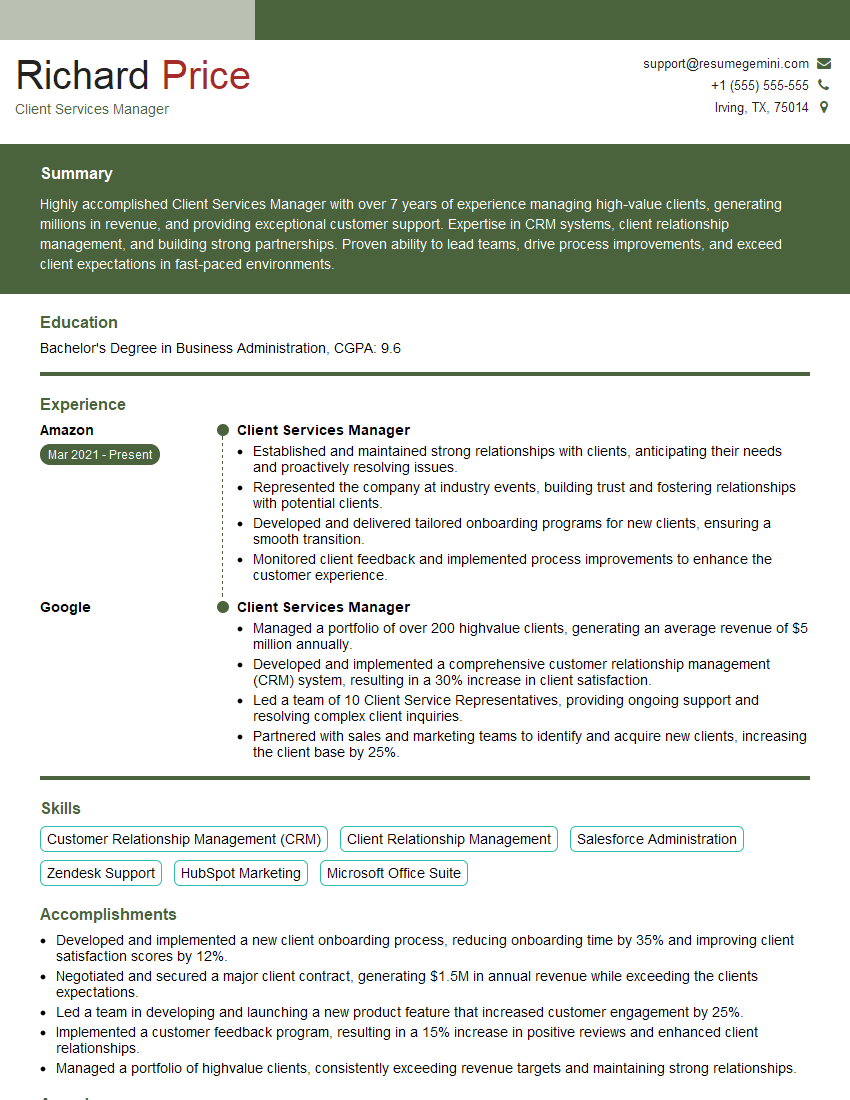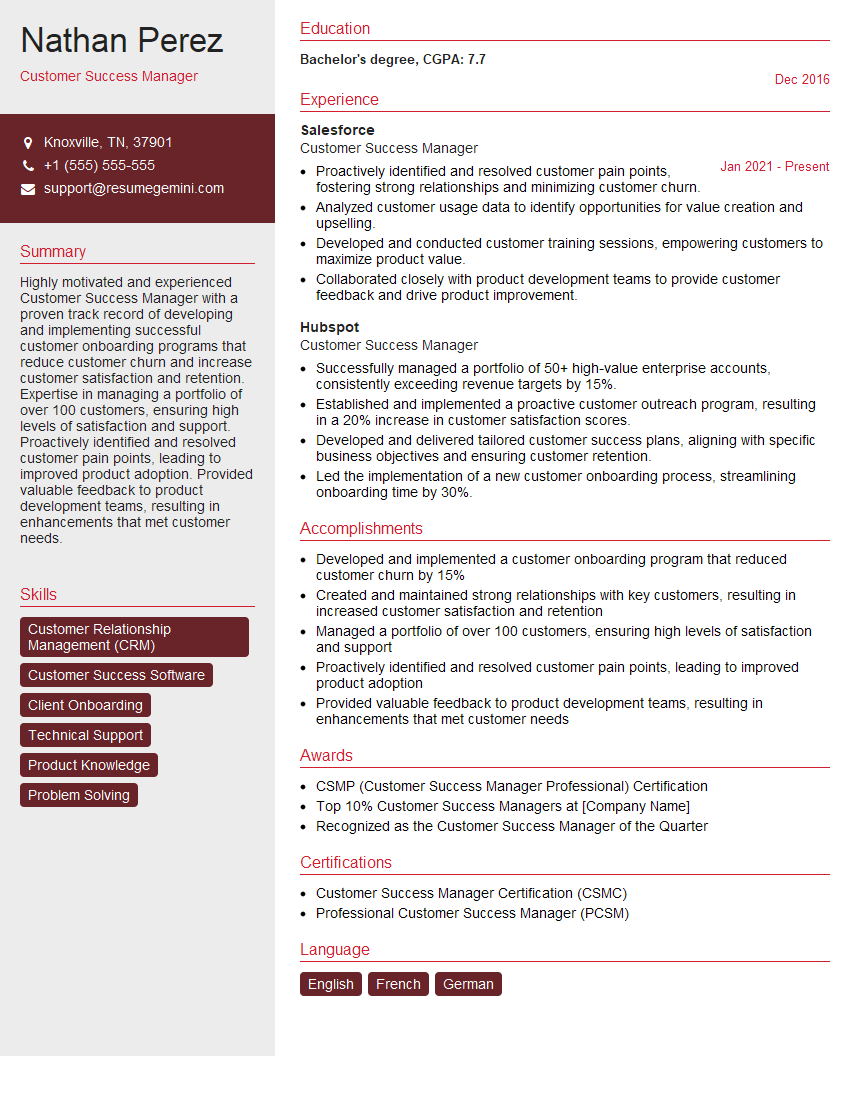The right preparation can turn an interview into an opportunity to showcase your expertise. This guide to Proven ability to meet deadlines and work under pressure interview questions is your ultimate resource, providing key insights and tips to help you ace your responses and stand out as a top candidate.
Questions Asked in Proven ability to meet deadlines and work under pressure Interview
Q 1. Describe a time you successfully met a tight deadline despite unexpected challenges.
Meeting tight deadlines, especially when faced with unexpected challenges, requires a proactive and adaptable approach. In my previous role at Acme Corporation, we were developing a crucial software update with a hard deadline of just three weeks. Two days before the deadline, a critical bug emerged in the core functionality, threatening the entire launch.
Instead of panicking, I immediately convened a team meeting. We used a structured problem-solving approach: first identifying the root cause of the bug, then breaking down the solution into smaller, manageable tasks. We prioritized these tasks based on their impact and dependency, using a Kanban board to visually track progress. This allowed us to delegate tasks effectively, assigning them to team members based on their expertise and availability. We also implemented an extended working schedule, focusing on the most critical aspects while communicating transparently with stakeholders about the delay. Through rigorous testing and collaborative efforts, we successfully resolved the bug and launched the software update within the revised timeline, only one day behind schedule. This experience highlighted the importance of clear communication, collaborative problem-solving, and effective prioritization under pressure.
Q 2. How do you prioritize tasks when facing multiple competing deadlines?
Prioritizing tasks with multiple competing deadlines requires a systematic approach. I use a combination of methods including the Eisenhower Matrix (urgent/important), a prioritized task list, and time blocking. The Eisenhower Matrix helps categorize tasks based on urgency and importance, allowing me to focus on high-impact, urgent tasks first. My prioritized task list uses a system of ranking, labeling tasks with deadlines, and assigning realistic time estimates for each. Time blocking involves allocating specific time slots in my day for tackling particular tasks, creating a structured schedule and preventing multitasking. For instance, I might allocate two hours to a high-priority coding task, followed by an hour for reviewing documents. This helps maintain focus and minimizes distractions.
Q 3. What strategies do you use to manage your time effectively?
Effective time management is crucial for meeting deadlines. My strategies center around planning, prioritization, and execution. I begin by creating a detailed plan, breaking down large tasks into smaller, manageable steps. This detailed plan enhances my clarity on what needs to be achieved and by when. Then, I use the prioritization techniques mentioned earlier to focus my energy on the most crucial tasks. I also utilize time-blocking techniques, minimizing interruptions through focused work sessions, often using the Pomodoro Technique (25 minutes of focused work followed by a 5-minute break). Regularly reviewing my progress and adjusting my plan as needed ensures I stay on track. Finally, I avoid procrastination by tackling the most challenging tasks early in the day when my energy levels are typically highest.
Q 4. Explain your approach to handling high-pressure situations.
Handling high-pressure situations involves a combination of preparation, strategic thinking, and emotional resilience. Firstly, thorough planning and preparation are essential. Knowing what tasks need to be done and how to do them efficiently reduces stress and anxiety when faced with pressure. Secondly, I maintain a calm and rational approach, focusing on finding solutions rather than dwelling on the pressure itself. Breathing exercises and short breaks can help manage stress and maintain focus. Thirdly, I believe in effective communication. Keeping stakeholders informed about progress and any potential challenges helps prevent misunderstandings and reduces pressure. Ultimately, my response to pressure is proactive and solution-oriented rather than reactive and panic-driven.
Q 5. How do you delegate tasks to ensure deadlines are met?
Delegating tasks effectively is key to meeting deadlines, especially in team settings. My approach involves careful selection of team members based on their skills and experience. I provide clear instructions and expectations for each task, setting specific deadlines and establishing clear communication channels. I also ensure that the team member understands the task’s importance and its impact on the overall project timeline. Finally, I follow up regularly, offering support and guidance but avoiding micromanagement. Empowering team members to take ownership of their tasks fosters responsibility and improves efficiency. For instance, if I need a presentation designed, I’ll delegate it to a team member proficient in graphic design, providing them with specific content guidelines and a clear deadline.
Q 6. Have you ever missed a deadline? What happened, and what did you learn?
Yes, I have missed a deadline once in my career. It was during a particularly complex project where unforeseen technical difficulties arose. While we had a detailed plan, we underestimated the complexity of integrating a new third-party system. I failed to effectively communicate the potential delays to management early enough. The lesson learned was the crucial importance of proactive and transparent communication. Early identification of potential roadblocks and timely updates to stakeholders are paramount in preventing missed deadlines, even if it means sharing potentially negative news. Since then, I have incorporated more robust risk assessment into my project planning and prioritize transparent communication at all stages of a project.
Q 7. Describe your experience using project management tools.
I have extensive experience using various project management tools, including Jira, Asana, and Trello. Jira, for example, I’ve used extensively for agile software development projects, leveraging its features for issue tracking, sprint management, and progress visualization. Asana’s task management capabilities are excellent for managing cross-functional projects with multiple stakeholders, and its integration with other tools boosts efficiency. Trello’s Kanban boards proved extremely useful for visual tracking of workflows and task assignments, particularly in projects requiring flexible task management and collaborative editing. My proficiency with these tools allows for efficient task management, improved team collaboration, and better tracking of project progress towards meeting deadlines.
Q 8. How do you proactively identify potential roadblocks that could impact deadlines?
Proactively identifying potential roadblocks is crucial for meeting deadlines. I approach this systematically, employing a combination of risk assessment and proactive communication. Firstly, I meticulously review project requirements, identifying potential bottlenecks early on. This might involve examining dependencies between tasks, assessing the availability of resources (both human and material), and anticipating potential technical challenges.
For example, if I’m leading a software development project, I’d examine the complexity of the code modules, the availability of specific libraries, and the potential for integration issues with existing systems. I then create a risk register, documenting each potential roadblock, its likelihood, and its potential impact on the timeline. This allows for proactive mitigation strategies. Finally, I schedule regular check-ins with team members to solicit their input and address potential issues before they become major problems.
Q 9. What’s your preferred method for tracking progress towards deadlines?
My preferred method for tracking progress is a combination of tools and techniques, tailored to the project’s complexity. For smaller projects, a simple spreadsheet or Kanban board suffices. For larger, more complex projects, I utilize project management software such as Jira or Asana. These tools allow for detailed task breakdown, assignment of responsibilities, progress tracking through visual dashboards, and effective communication regarding roadblocks. I prioritize visual representations of progress – charts, graphs, and Kanban boards – to quickly grasp project status. Regular updates and visual progress tracking give a clear overview and facilitate informed decision-making.
Q 10. How do you communicate effectively with your team about deadlines and progress?
Effective communication is paramount for on-time project completion. I maintain open and consistent communication with my team throughout the project lifecycle. This includes regular status meetings, both formal and informal, to discuss progress, roadblocks, and potential adjustments to the timeline. I utilize various communication channels, including email, instant messaging, and project management tools to ensure everyone remains informed and any queries are addressed promptly. I also advocate for clear and concise communication, using visual aids where necessary to help the team fully grasp the project’s status and deadlines.
For instance, I would utilize project management software to assign tasks and provide regular updates on task completion. I also utilize quick daily stand-up meetings to address immediate concerns, maintaining a focus on transparency and collaboration.
Q 11. How do you handle conflicting priorities when working under pressure?
Conflicting priorities are inevitable, particularly when working under pressure. My approach prioritizes a structured method to handle them efficiently. Firstly, I carefully assess the urgency and importance of each task, using a prioritization matrix (such as Eisenhower Matrix, categorizing tasks based on urgency and importance). Tasks that are both urgent and important are tackled first, followed by important but not urgent, then urgent but not important. Tasks that are neither urgent nor important are either delegated or eliminated. Open communication with stakeholders is vital – I discuss the constraints and make data-driven decisions on task prioritization, ensuring everyone is aligned and informed.
Q 12. Describe a time you had to re-prioritize tasks due to a changing deadline.
In a previous role, we were developing a new mobile application with a hard launch date. A week before the deadline, a critical bug was discovered in the core functionality. This necessitated a re-prioritization of tasks. We immediately held an emergency meeting to assess the situation and determine the impact on the launch date. We decided to temporarily postpone several minor features, focusing our efforts on resolving the critical bug. This meant re-allocating resources and extending the work hours of the development team, but it enabled us to launch the app with the critical bug fixed, although some features were delayed. This required clear communication across all teams and stakeholders, explaining the situation and the revised timeline. Transparency was crucial in maintaining confidence and managing expectations.
Q 13. How do you maintain focus and avoid burnout when working under pressure?
Maintaining focus and avoiding burnout under pressure requires a proactive approach to self-care and time management. I incorporate regular breaks into my workday, utilizing the Pomodoro Technique (25 minutes of focused work followed by a 5-minute break) to maintain concentration. I also prioritize adequate sleep, exercise, and a healthy diet to support my physical and mental well-being. Furthermore, I practice mindfulness techniques like meditation to reduce stress and improve focus. It’s essential to acknowledge that sometimes pushing oneself to the limit might be necessary, but sustained effort requires a balanced approach.
Q 14. What techniques do you use to stay organized and manage your workload?
Staying organized and managing my workload involves a multi-faceted approach. I utilize task management systems, like to-do lists and project management software, to break down large tasks into smaller, manageable steps. This provides a clear roadmap and prevents feeling overwhelmed. I prioritize tasks based on their importance and urgency, focusing on high-impact tasks first. Regularly reviewing my schedule and to-do list allows for adjustments as needed. Finally, I leverage digital tools like calendar apps for scheduling and reminders to avoid missing important deadlines. This structured approach enables me to stay focused, efficiently manage my time and deliver projects on time.
Q 15. How do you handle criticism or feedback when under pressure to deliver?
Criticism, especially under pressure, can feel jarring. However, I view it as an invaluable opportunity for growth. My approach is threefold: First, I actively listen to understand the feedback’s intent, focusing on the specific points raised rather than getting defensive. Second, I analyze the criticism objectively, separating valid concerns from subjective opinions. For instance, if feedback points to a missed deadline, I’ll analyze the root cause: was it a miscalculation, an unforeseen obstacle, or a communication breakdown? Third, I formulate an action plan. This includes acknowledging the feedback, outlining steps to rectify the issue (if applicable), and setting clear expectations for future performance. This systematic approach transforms criticism into a learning experience, fostering continuous improvement and stronger performance even under tight deadlines.
For example, on a recent project with a tight turnaround, I received feedback that a particular report lacked crucial data. Instead of reacting defensively, I investigated and found a flaw in my data sourcing process. I promptly rectified this, communicated the fix to the stakeholder, and implemented changes to prevent similar occurrences. This proactive response not only addressed the immediate issue but strengthened the project’s overall quality and my own methodology.
Career Expert Tips:
- Ace those interviews! Prepare effectively by reviewing the Top 50 Most Common Interview Questions on ResumeGemini.
- Navigate your job search with confidence! Explore a wide range of Career Tips on ResumeGemini. Learn about common challenges and recommendations to overcome them.
- Craft the perfect resume! Master the Art of Resume Writing with ResumeGemini’s guide. Showcase your unique qualifications and achievements effectively.
- Don’t miss out on holiday savings! Build your dream resume with ResumeGemini’s ATS optimized templates.
Q 16. How do you build relationships with stakeholders to manage expectations around deadlines?
Building strong stakeholder relationships is paramount for managing expectations. My strategy focuses on proactive, transparent communication. This involves clearly outlining project timelines, potential roadblocks, and contingency plans from the outset. I utilize regular check-ins – both formal and informal – to keep stakeholders informed of progress. I utilize tools like project management software (e.g., Jira, Asana) to provide visual updates on task completion and progress against milestones. This transparency fosters trust and allows for collaborative problem-solving. When unforeseen delays arise, I communicate them promptly, explaining the reasons behind the delay and presenting viable solutions. This open communication prevents misunderstandings and fosters a collaborative spirit.
For example, in a previous project, I used regular stand-up meetings with stakeholders to discuss progress, challenges and concerns. By addressing concerns immediately, we made adjustments to the project plan and prevented major setbacks. This consistent, transparent communication built trust and allowed me to successfully navigate potential conflicts and maintain alignment with stakeholder expectations.
Q 17. How do you measure your success in meeting deadlines and managing workload?
Measuring success in meeting deadlines and managing workload isn’t simply about hitting deadlines; it’s about achieving those deadlines efficiently and effectively while maintaining quality. I use a multi-faceted approach. First, I track on-time project completion rates. Second, I evaluate the quality of deliverables. Were the projects completed to specification and to the client’s satisfaction? Third, I analyze my own workload management: Did I prioritize tasks effectively? Did I delegate appropriately? Were there any bottlenecks I could have avoided? Finally, I gather feedback from colleagues and stakeholders to get a holistic view of my performance. This comprehensive analysis allows for continuous improvement. I use project management software to track key metrics and create reports, allowing for data-driven insights into my performance.
For instance, I might track my project completion rate, the number of successful project deliveries within the proposed time frame, and customer satisfaction ratings. These metrics offer a tangible assessment of my success, showing both positive results and areas requiring improvement.
Q 18. Describe your experience working in a fast-paced environment.
I thrive in fast-paced environments. My experience working at [Previous Company Name] provided ample opportunity to hone my skills in this area. We consistently handled multiple projects concurrently, often with rapidly shifting priorities. The key to success in this kind of environment is adaptability, effective prioritization, and strong time management skills. I excel at prioritizing critical tasks, delegating when appropriate, and managing my time efficiently. I am comfortable working under pressure and consistently deliver high-quality work even when facing tight deadlines. I learned the importance of clear communication and using project management tools to stay organized and on track. My approach is to remain calm, focus on the task at hand, and seek assistance when needed.
One specific example involved a critical software update that needed to be released within a week. With a small team and a mountain of tasks, we utilized agile methodologies to streamline our workflow. Through consistent communication and teamwork, we successfully delivered the update on time. The ability to remain calm under pressure and leverage team strength was a crucial factor in our success.
Q 19. How do you adapt your work style to different team dynamics and project demands?
Adaptability is crucial in a dynamic work environment. My approach to adapting my work style involves understanding the team’s dynamics and the project’s specific demands. I observe team communication styles and adjust my communication accordingly. Some teams prefer detailed email updates; others prefer quick check-ins. I also observe the team’s workflow and preferences. Some teams prefer a highly structured approach; others favor a more flexible methodology. I analyze the project requirements and adjust my approach based on urgency, complexity, and deliverables. I am proficient in several project management methodologies (e.g., Agile, Waterfall) and readily adapt to the most appropriate approach for each project.
For example, on one project, I worked with a team that was highly collaborative and preferred using a Kanban board for task management. I adjusted my workflow to align with their preferences. In another project, the team favoured a more structured waterfall approach. I adapted my communication style and my approach to deliver the project within their parameters.
Q 20. What are your strategies for preventing stress and maintaining productivity under pressure?
Preventing stress and maintaining productivity under pressure requires a proactive approach. I prioritize sleep, exercise, and a healthy diet to ensure I am physically and mentally well-equipped to handle demanding workloads. I also prioritize breaks and use mindfulness techniques (e.g., deep breathing exercises) to manage stress levels throughout the day. I break down large tasks into smaller, more manageable steps, making progress more visible and reducing feelings of being overwhelmed. Furthermore, I make time for hobbies and activities outside of work to maintain a healthy work-life balance. This holistic approach allows me to handle pressure effectively and maintain peak performance.
For instance, during a particularly demanding project, I implemented a daily routine that involved a short morning meditation, regular breaks, and finishing work promptly at the end of the day to avoid burnout. This ensured that my focus and energy levels were maintained consistently.
Q 21. How do you use technology to improve your time management and productivity?
Technology plays a significant role in enhancing my time management and productivity. I rely on project management software (e.g., Asana, Jira, Trello) for task organization, prioritization, and progress tracking. These tools provide a clear overview of my workload, deadlines, and dependencies. I also utilize calendar applications for scheduling meetings and appointments, and communication tools (e.g., Slack, Microsoft Teams) for quick and efficient communication with team members and stakeholders. I employ automation tools wherever possible, such as using email automation for routine communication. Finally, I utilize time-tracking software to monitor my time allocation and identify areas for improvement. This data-driven approach enables me to optimize my workflow and improve my overall efficiency.
For example, using Asana allows me to visualize the project timeline and track progress against milestones, which helps in proactively identifying potential bottlenecks or delays and addressing them in advance.
Q 22. Describe your experience with Agile methodologies and their impact on meeting deadlines.
Agile methodologies, such as Scrum and Kanban, are iterative approaches to project management that emphasize flexibility and collaboration. My experience with Agile has significantly improved my ability to meet deadlines. Instead of rigidly adhering to a predetermined plan that’s prone to unforeseen delays, Agile allows for continuous adaptation.
For instance, in a recent project involving the development of a new e-commerce platform, we used Scrum. The iterative sprints (typically 2-4 weeks) allowed us to deliver functional components regularly. Each sprint concluded with a working increment, providing visibility into progress and allowing for course correction. This iterative process, coupled with daily stand-up meetings for transparent communication, ensured that we stayed on track and met the final deadline successfully.
Furthermore, Agile’s emphasis on frequent feedback loops, both internally within the team and with clients, enabled us to address potential issues early on, preventing major roadblocks later in the project lifecycle. This proactive approach is crucial for timely project completion.
Q 23. How do you identify and mitigate potential risks to project deadlines?
Identifying and mitigating risks to project deadlines requires a proactive and systematic approach. I typically employ a risk assessment framework that involves:
- Identifying potential risks: This involves brainstorming potential problems, reviewing past project experiences, and considering external factors. I use tools like SWOT analysis and risk register.
- Analyzing risk probability and impact: Once risks are identified, I assess their likelihood of occurrence and potential consequences on the project timeline. This helps prioritize mitigation efforts.
- Developing mitigation strategies: For each identified risk, I create a plan to reduce its probability or impact. This might include allocating buffer time, developing contingency plans, or assigning additional resources.
- Monitoring and controlling risks: Throughout the project, I continuously monitor risks and evaluate the effectiveness of mitigation strategies. Adjustments are made as needed.
For example, in a previous project, we anticipated potential delays due to third-party API integration. Our mitigation strategy involved establishing clear communication channels with the API provider, setting up regular testing sessions, and including buffer time in the schedule. This proactive approach ensured the integration was completed on time without affecting the overall deadline.
Q 24. How do you stay calm and focused when things don’t go according to plan?
Maintaining composure and focus under pressure is a skill honed over time. My approach involves a combination of techniques:
- Deep breathing exercises: Taking a few deep breaths helps to calm my nervous system and regain focus.
- Prioritization: When things get overwhelming, I prioritize tasks based on urgency and importance, focusing on the most critical ones first.
- Breaking down large tasks: Complex projects can feel daunting. Breaking them down into smaller, more manageable tasks makes them less intimidating and easier to tackle.
- Seeking support: I don’t hesitate to reach out to colleagues or mentors for assistance or advice when needed. A fresh perspective can often be invaluable.
- Positive self-talk: I remind myself of past successes and my capabilities to maintain a positive attitude.
Think of it like a marathon, not a sprint. Maintaining a consistent pace, rather than panicking when encountering obstacles, is key to reaching the finish line.
Q 25. What are your strengths and weaknesses in managing time and meeting deadlines?
My strengths in time management and deadline adherence include strong organizational skills, effective prioritization techniques, and proactive planning. I use tools like project management software (e.g., Jira, Asana) to track progress, allocate resources, and manage my time effectively. I’m also adept at anticipating potential delays and implementing preventative measures.
My weakness, however, is occasionally overcommitting myself. While I’m efficient, I sometimes take on more than I can realistically handle. I’m actively working on improving this by learning to say ‘no’ to tasks that don’t align with my priorities and by more accurately estimating the time required for projects. This involves breaking down tasks further and more realistically assessing potential roadblocks.
Q 26. Describe a situation where you had to make difficult decisions to meet a critical deadline.
During the development of a critical software update, we discovered a major bug just a week before the launch deadline. The bug threatened to significantly delay the release, impacting both our company’s reputation and our clients’ operations.
The decision I had to make was whether to proceed with a less-than-perfect solution and prioritize the deadline or delay the launch to fully fix the bug. After careful consideration, weighing the risks and potential consequences of both options, I opted for a partial solution that addressed the most critical aspects of the bug while ensuring system stability. This allowed us to meet the deadline, minimizing negative impact. We then dedicated additional resources to fully resolve the bug in a subsequent update.
This decision wasn’t easy, but it was the most responsible course of action given the circumstances. Open and honest communication with the stakeholders was key to managing expectations and gaining their support for the chosen approach.
Q 27. How do you balance quality of work with the need to meet deadlines?
Balancing quality and deadlines requires careful planning and prioritization. It’s not about compromising quality for speed; it’s about finding efficient ways to deliver high-quality work within the allotted time.
My approach includes:
- Clear specifications and acceptance criteria: This ensures everyone understands the quality standards from the outset.
- Iterative development and testing: Regular testing throughout the development process helps identify and address quality issues early, preventing major rework later.
- Prioritization of critical features: Focusing on core functionality first ensures that essential elements meet quality standards even if less critical features require further development post-launch.
- Effective time management: Careful task allocation and scheduling help to manage time effectively without sacrificing quality.
This approach ensures that the essential aspects meet the defined quality, even if some non-critical features are streamlined or deferred to later iterations, thus maintaining a balance between quality and speed.
Q 28. How do you handle interruptions and distractions when working under pressure?
Handling interruptions and distractions while working under pressure is crucial for maintaining productivity and meeting deadlines. My strategies include:
- Communicating boundaries: I inform colleagues of my availability and periods of focused work to minimize unnecessary interruptions.
- Time blocking: I schedule specific blocks of time for focused work, dedicating them to specific tasks without switching contexts. This minimizes cognitive switching costs.
- Utilizing noise-cancelling headphones: This helps create a more focused work environment by reducing external noise distractions.
- Using productivity tools: Apps and software for task management and focus help me stay on track and minimize distractions.
- Taking short breaks: Regular short breaks help to prevent burnout and maintain focus throughout the day.
Essentially, creating a conducive work environment and establishing clear boundaries helps me minimize distractions and stay focused even in high-pressure situations.
Key Topics to Learn for “Proven Ability to Meet Deadlines and Work Under Pressure” Interview
- Time Management Strategies: Explore various time management techniques like the Pomodoro Technique, Eisenhower Matrix, and time blocking. Understand how to prioritize tasks effectively.
- Prioritization and Task Delegation: Learn to identify high-impact tasks and delegate effectively when appropriate. Discuss strategies for assessing task urgency and importance.
- Stress Management and Resilience: Discuss techniques for managing stress and maintaining focus under pressure. Highlight your ability to remain calm and productive in demanding situations.
- Proactive Problem Solving: Showcase your ability to anticipate potential roadblocks and develop proactive solutions. Provide examples of how you’ve mitigated risks and prevented delays.
- Communication and Collaboration: Explain how you effectively communicate progress updates, challenges, and potential delays to stakeholders. Discuss your collaborative approach to problem-solving.
- Using Project Management Tools: Discuss your experience using project management software (e.g., Trello, Asana, Jira) to track progress, manage deadlines, and collaborate effectively.
- Adaptability and Flexibility: Demonstrate your ability to adjust to changing priorities and unexpected challenges while maintaining productivity and meeting deadlines.
- Self-Assessment and Continuous Improvement: Showcase your ability to reflect on past performance, identify areas for improvement in time management and stress management, and implement changes for future success.
Next Steps
Mastering the ability to meet deadlines and work under pressure is crucial for career advancement. It demonstrates key skills highly valued by employers: reliability, efficiency, and problem-solving aptitude. To showcase these skills effectively, crafting a strong, ATS-friendly resume is paramount. ResumeGemini can help you build a professional and impactful resume that highlights your accomplishments and emphasizes your ability to thrive in fast-paced environments. We provide examples of resumes tailored to showcase this critical skill; explore them to gain valuable insights and inspiration for crafting your own compelling narrative.
Explore more articles
Users Rating of Our Blogs
Share Your Experience
We value your feedback! Please rate our content and share your thoughts (optional).
What Readers Say About Our Blog
These apartments are so amazing, posting them online would break the algorithm.
https://bit.ly/Lovely2BedsApartmentHudsonYards
Reach out at [email protected] and let’s get started!
Take a look at this stunning 2-bedroom apartment perfectly situated NYC’s coveted Hudson Yards!
https://bit.ly/Lovely2BedsApartmentHudsonYards
Live Rent Free!
https://bit.ly/LiveRentFREE
Interesting Article, I liked the depth of knowledge you’ve shared.
Helpful, thanks for sharing.
Hi, I represent a social media marketing agency and liked your blog
Hi, I represent an SEO company that specialises in getting you AI citations and higher rankings on Google. I’d like to offer you a 100% free SEO audit for your website. Would you be interested?













